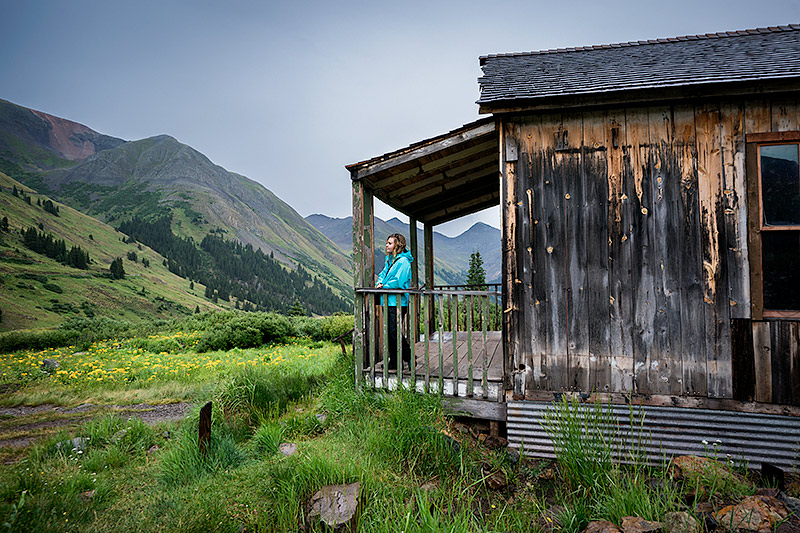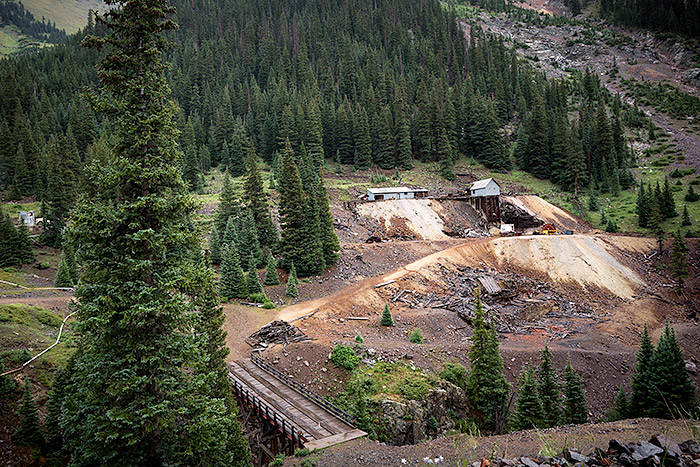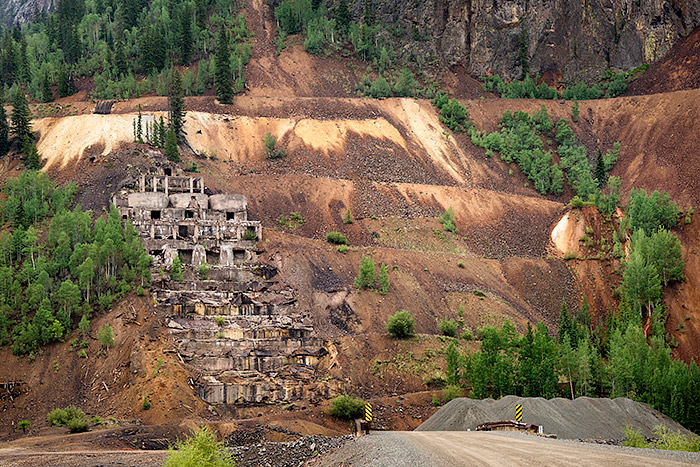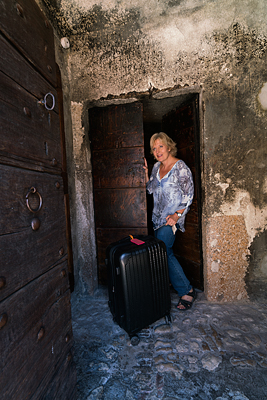Did you know that there are 1,500 ghost towns in Colorado? Sure, some are nothing more than a few scattered remnants, but 600 of them have actual structures left over from the mining days.


Standing on the front porch of the Gustavson’s house in Animas Forks Ghost Town
Planning my Colorado trip, I starred Animas Forks on my must-do list. Now on the National Register of Historic Places, it’s one of Colorado’s best preserved ghost towns and a top attraction on the Alpine Loop Scenic Byway, a 65 mile narrow, unpaved road between the mountain towns of Silverton, Lake City and Ouray.
Tourists are free to wander through the nine remaining buildings in the former town nestled in a mountainous valley beside a flowing river. Structures have been stabilized by the Bureau of Land Management, who manages the site and provides maps and brochures at the parking area.
Driving there…
Originally, I planned on driving there— having read many accounts that the road was passable by regular two-wheel drive vehicles. One local confirmed that her mother even drove there in a little Honda. Well, then that should be a no-brainer. I was driving a four-wheel drive Jeep after all!


Another mine in the area en route to Animas Forks
So my teenage daughter, Jordan, and I began the 12 mile journey northeast of Silverton on County Road 2. We traveled past an RV park, an old mine, rocks with dark mine shaft holes and the processing plant leftover from the Sunnyside mine in Eureka. This mine was so rich in gold that it operated continuously from 1873 until 1931.


What’s left of the processing plant, Eureka mine, Silverton, CO
After about 20 minutes of driving, we turned left onto the road leading to Animas Forks ghost town which paralleled the river in the gorge. It began to rain. As the road narrowed and climbed, deep ruts appeared. When I saw the large sign: “4X4 TRAIL BEYOND THIS POINT. HIGH GROUND CLEARANCE REQUIRED,” I knew we’d better turn around. There were holes with standing water (who knew how deep?), curving unprotected cliff edges, and oncoming ATV’s that were buzzing straight toward us in lightning speed. Ah, no! Not in a car rental. So we turned around. Back in town, I did a google search for Jeep tours. (I was surprised by the lack of tourist brochures in town for any kind of organized tour. Even at the Visitor Center.)


Joining a Jeep Tour…
There are in fact 2 companies that offer jeep tours and ATV rentals, both located on Main Street. We called and booked the afternoon tour with San Juan Backcountry. When we showed up to pay at 3:30pm, we learned were the only ones on the tour. Apparently most people rent ATV’s. Our guide welcomed the change—not having to be responsible for careless or incompetent drivers getting carried away on unfamiliar roads on a guided ATV tour—and gave us ample time to roam on our own once we arrived.
It’s funny that I hated history as a kid. My worst grades were in US History cuz memorizing dry facts and dates were soooo boring. But wandering through ruins of former pasts my imagination runs rampant wondering about the people who lived there, craving to know their stories— and yes, even some history.


Arriving in Animas Forks
A little history…
Back in the late 1800’s, the possibility of striking it rich lured people to this SW region of the state. Even immigrants from Eastern Europe and Scandinavia came, eager to mine silver and gold. Hard-rock mining was done here, a very labor intensive process. Prospectors first dug tunnels into solid rock, looking in the ore for pockets of silver or gold. Miners then hauled out the ore by cart and brought it to the mill where they began the process of separating rock fragments by size, crushing them and extracting the minerals.
In 1875, transportation magnate Otto Mears built a wagon road linking mining communities to the central hub of Animas Forks which supported three mills and was in close proximity to many mines including Iron Cap, Black Crow, Gold Prince, Columbus, Red Cloud, Silver Coin, Early Bird, Little Roy and the Big Giant. In 1877, Animas Forks was a stagecoach stop on Otto’s toll road between Silverton and Lake City.


Overview of Animas Forks Ghost Town
By 1876, 450 people lived in Animas Forks. The bustling mining community boasted 2 mines, 30 miner’s cabins, two boarding houses, a hotel, restaurant, saloon, post office, assay office, general store and even a newspaper. But sitting 11,200 ft high in a mountain valley among fir and spruce forests— it was not an easy place to live. Winters were harsh. And avalanches were common—buildings buckled in its path. In 1884, cabins were buried under 25 feet of snow during a blizzard that lasted 3 weeks. People had to dig tunnels under the drifts to get around town. (No, it’s your turn to go get eggs/whisky/toilet paper!) No wonder most people migrated south to Silverton every Fall.
There were just 4 families who lived in Animas Forks year round.
One of them was the Duncan family. (The tallest house in the picture above belonged to them.) It was the largest and most distinctive home in Animas Forks, a two story clapboard wood-sided Victorian house with bay windows that overlooked the Columbus Mine.


Bay window of the Duncan house overlooking toll house and Columbus Mine in Animas Forks
According to the Silverton Standard newspaper, William Duncan, a snowshoe mail carrier and miner, built this house in 1879 after making his fortune in sales and investments. The house still standing is a testament to its construction allowing the family to tolerate brutal winters instead of escaping to warmer climes.


Back room kitchen area of Duncan house


Upstairs of the Duncan house, Animas Forks
The Duncan home is often mistakenly referred to as the Walsh House. Thomas Walsh, who made gazillions from gold mining in Ouray, never lived here. He supposedly purchased it for his daughter, Evalyn, but she never lived here either. Instead, she eloped with Edward Beale McLean, heir to The Washington Post, and lived as a socialite in DC—the place to be for the elite. (Her wedding present was the 45 carat Hope Diamond that she spotted in Paris on her honeymoon—gosh, thanks, Dad! ~~~and if you want a really fascinating read about this socialite and the ensuing tragedies believed to occur from wearing this cursed gem, check out this article.)


Strolling over to the neighbor’s house in the rain…




This home was the creepiest, and I couldn’t find any history about who lived there. Or identify what that smell was!
It was definitely rougher inside. Strange bits of fabric hanging from the rafters were kinda spooky.

 And the hallway straight ahead led to a privy— simply a hole in a wooden box seat.
And the hallway straight ahead led to a privy— simply a hole in a wooden box seat.




Our guide popped in to make sure we were OK, since there’s been reports of some odd things happening inside here. Rickety boards and a strong (mold?) odor propelled us out the door pretty quickly.
We walked up to porch of the next house…what a view! Golden wildflowers blooming in the pine forested valley were framed by 13,000 ft peaks.


This home belonged to the Gustavsons, another family who braved the year round winter conditions. Being Scandinavian, this couple was probably used to this kind of weather. According to a sign inside their former home, Alma was from Finland and Charles from Sweden. They bought the land for $1 back in 1906 and lived here for four years. The most notable feature of their two bedroom home was an indoor toilet—which was really a glorified outhouse with a connected hallway. Alma decorated the walls with floral linen wallpaper (remnants framed inside the home).


Their water source during the winter was simply melted snow that Alma scooped out of an open window, since snow often accumulated to the rooftop. Charles worked in the Gold Prince mine and mill. Their 2nd child, Carl, was born in October 1906 in a tent where the couple lived with their 2 year old daughter while they were building their home. In 1910, when the mine closed, they sold their home for $110 and moved to another mine near Silverton, where their 4th child was born.


These tiny little windows made sense in a bitter cold mountain climate—kept out the drafts and were still functional for checking the weather and spying on your neighbors.


Leaving the Gustavson’s home we went down the hill (to the building beyond the railing in the pic)—and stepped inside the boarding house that was once home to 150 miners. Partial remains of this Hip-roofed structure is where the miners hung their hats after a long, grueling day in the surrounding mines.


Former boarding house for 150 miners
It was hard to find much information about the other people who lived here…but I did dig up a few facts.
Frederich Aderhold, a young blacksmith, married Miss Anna Rehmisers at Animas Forks on May 29, 1882. Three years later, according to the local newspaper, they sadly lost their 3 month old twin babies.
Brothers Edwin and Squire Brown built and ran a grand hotel, the Kalamazoo House, which offered live piano music and the only telephone service in Animas Forks. Edwin Brown and his business partners Levi Woodbury and Harrison Garrison built a dam on the Animas River (still seen today) and operated a water-powered sawmill.

 One of nine buildings that remain. This was either the tiny jail or the toll house that sat across from the Columbus Mine at the fork of the Animas River.
One of nine buildings that remain. This was either the tiny jail or the toll house that sat across from the Columbus Mine at the fork of the Animas River.


Columbus Mine, Animas Forks Ghost town
The demise…
Fire! A huge fire destroyed most of the business district on October 22, 1891. The fire that started in the kitchen of the Kalamazoo spread quickly, burning the hotel and 14 additional buildings, causing $20,000 in damage.
And then there was the silver crash in 1893. Many disheartened families left town, and surrounding mines operated minimally for the next decade. But in 1903 , there was renewed energy and dreams of prosperity. Otto Mears extended his railroad from Silverton to Animas Forks in 1904, and the same year Gold Prince Mill was built in town. The mill, built of structural steel, was the largest in Colorado with 100 stamps and 500- ton per day capacity. Ore arrived from the Gold Prince Mine by a 12,600-ft long aerial tramway. Its success was short-lived however, as the mill closed six years later. By 1917, most of the mill was dismantled to build a new facility in Eureka, closer to Silverton.
Miners continued to work in the surrounding mines and the nearby Frisco Mill. But another fire blazed through town in September 1913, burning a boarding house and a few saloons. Again, many left and this time, the town never rebounded. When the Frisco Mill closed the next year, in 1914, the town of Animas Forks was abandoned.
Avalanches and high winds swept away the remaining buildings, eroding all but the nine left today….leaving Animas Forks a forlorn, but not forgotten, little ghost town.

 Driving back toward Silverton, we passed some beautiful scenery…
Driving back toward Silverton, we passed some beautiful scenery…


Can you spot the little cabin at the base of the waterfall in the pic above? Maybe it belonged to a prospector who tunneled into the rocks looking for silver?


Here’s a closer view, or two… Our guide was great about stopping for photos along the way home!


Know before you go:
Rent an ATV in town, or drive your own 4-wheel vehicle. Alternatively, join a guided Jeep tour from Silverton. We went with San Juan Backcountry. Highly recommended!
Be prepared for the altitude. Flatlanders: don’t attempt this 11,000 ft elevation if this is your first day in town. Altitude sickness can strike at elevations above 8,000 ft. Best to acclimate gradually (experts recommend spending 24 hours for every 1,000 ft gain).
Bring a rain jacket in July and August as afternoon thunderstorms are common.
For more info:
Caroline Bancroft, a Coloradan who wrote history for The Denver Post back in 1928, published a fascinating little book about Colorado’s Unique Ghost Towns that is now free online. To see historical photos and read her descriptions, check out this link.


.jpg)
